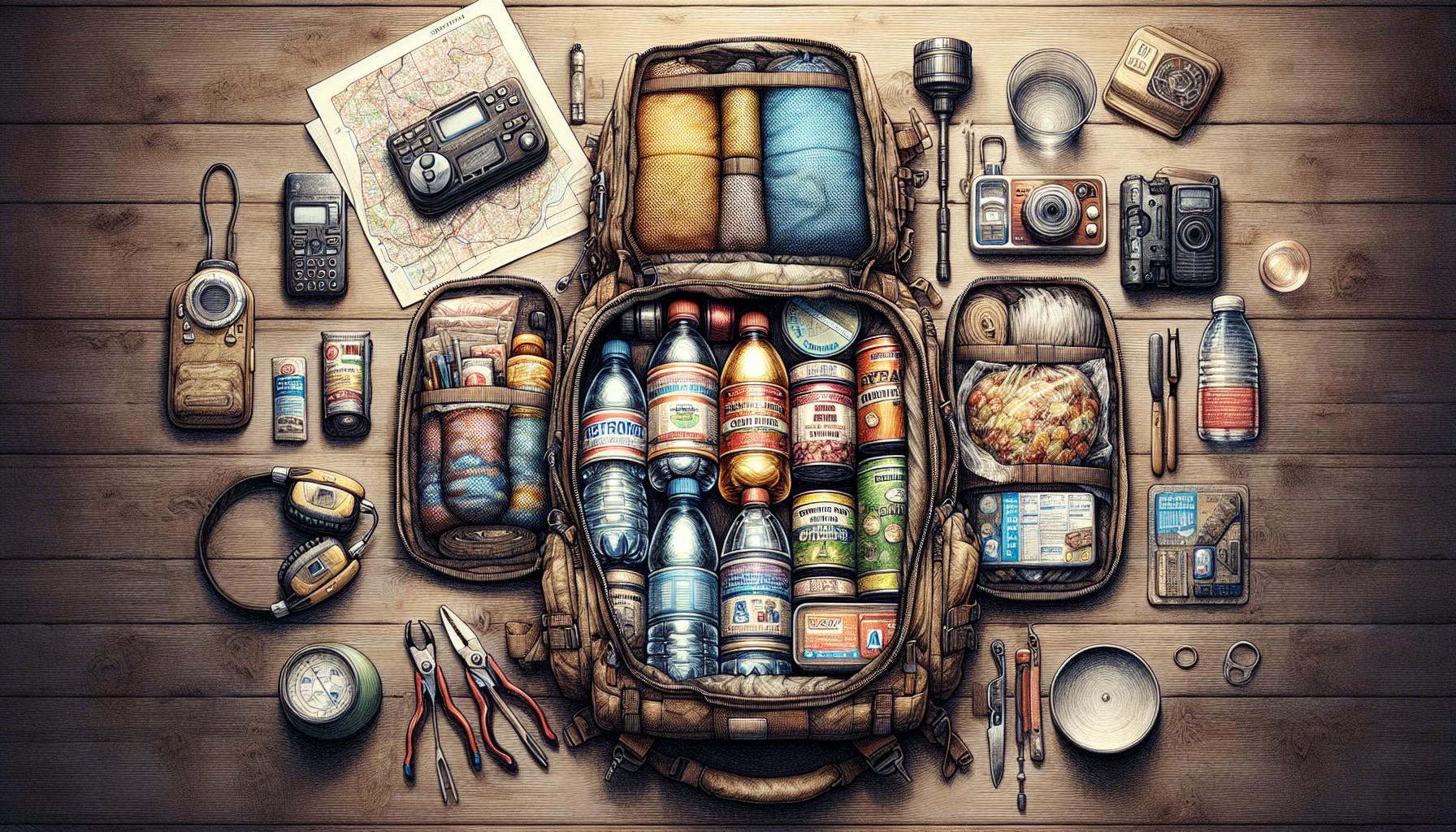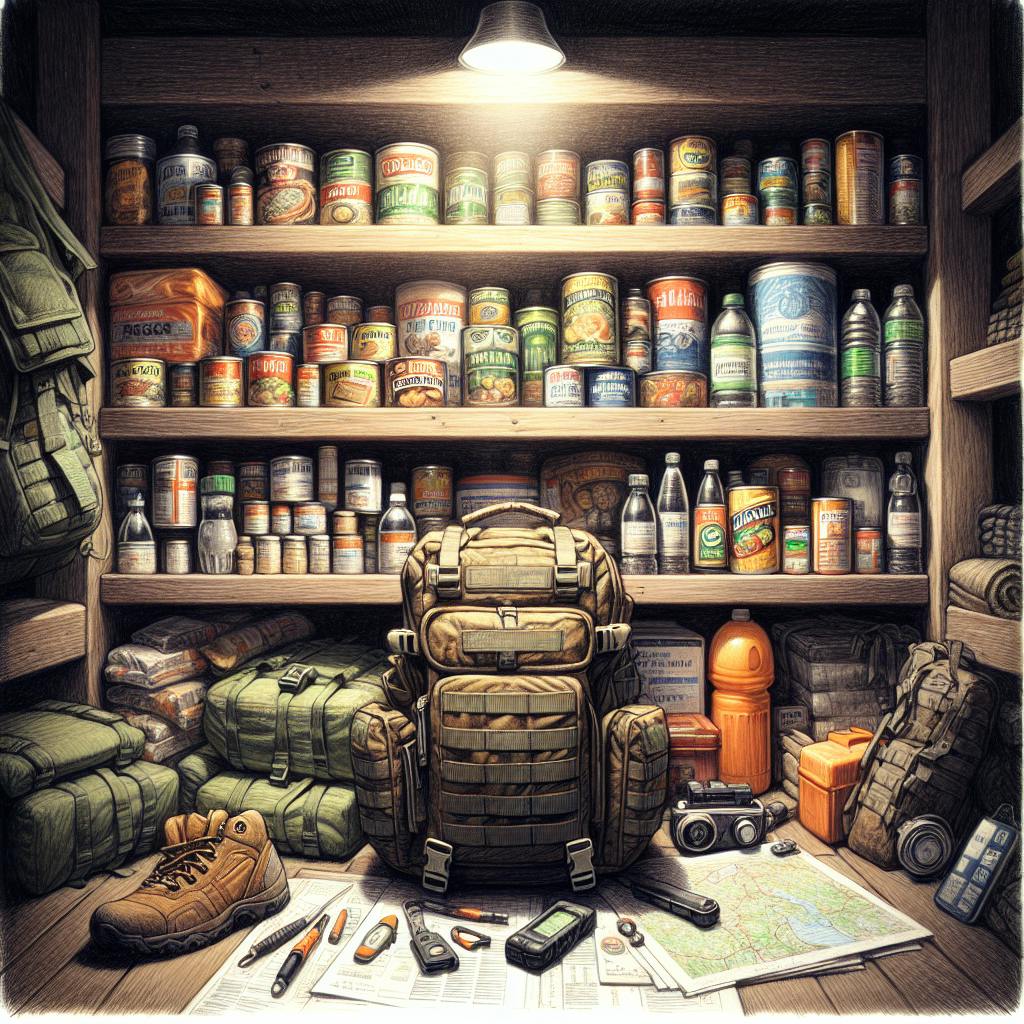When crisis strikes, having a well-stocked first aid kit can make all the difference.
This article will provide a complete list of supplies to include in a go bag first aid kit, ensuring you're fully prepared to respond to medical emergencies.
We'll cover everything from essential wound care items to over-the-counter medications, with tips on customizing your kit for specific needs and keeping supplies up-to-date.
Equipping Your Ultimate Survival Kit Bug Out Bag
Understanding the Purpose of a Go Bag First Aid Kit
A go bag first aid kit is a critical component of any bug out bag. It contains medical supplies and medications to treat injuries and illnesses when immediate access to professional medical care is not available. Having a well-stocked first aid kit can be the difference between life and death in an emergency situation.
When building your go bag first aid kit, tailor it to your specific needs and situation. Consider factors like the climate and terrain you'll be in, the length of time you may be away from medical facilities, the number of people in your group, and any unique medical needs. The kit should address the most likely injuries and conditions you may face.
Some essential items to include are bandages, gauze, trauma supplies, medications, tools, personal protection equipment, and documentation. Customize based on your medical knowledge, environment, and group. The key is balancing comprehensiveness with portability.
Key Considerations for Building Your First Aid Kit
When assembling your go bag first aid kit, keep these key factors in mind:
-
Duration of your trip or time away - The longer you will be away from professional medical care, the more supplies you will need. Plan for at least 72 hours.
-
Climate and terrain - Hot or cold weather may require specific treatments. Adjust your supplies based on likely environmental exposures.
-
Group size and composition - The number of people and their ages/health impacts your first aid needs.
-
Activity types - Certain activities have higher injury rates. Prepare for likely incident types.
-
Medical conditions in group - Account for chronic illnesses, prescriptions, allergies etc.
-
Your medical skills - Match supplies to your training so they can be used properly. Consider taking classes.
Carefully evaluating these elements will help you build a comprehensive, specialized go bag first aid kit.
The Intersection of Preparedness and Practicality
When building out your first aid kit, you need to find the right balance between being fully prepared for medical situations and maintaining a portable, efficient kit. Key steps include:
-
Take inventory of the likely injuries and incidents for your situation. Prioritize these in your supplies selection.
-
Understand realistic constraints like weight, bulk, and duration away. Do not overpack!
-
Categorize supplies into modules like airway, bleeding, infection care. This helps avoid duplication and ensures key areas are covered.
-
Utilize compact, multi-use items whenever possible without compromising care. Space saving choices are critical.
-
Consult medical references to ensure you understand proper techniques for included items. All supplies should align with your skills.
Finding this crossover point between preparedness and practicality takes thoughtfulness and risk analysis. The result is a tailored go bag first aid kit you can truly rely on when needed most.
Customizing for Unique Needs: Seniors, Pets, and Children
It's important to consider the unique medical needs of seniors, children, and pets when customizing your go bag first aid kit. Key steps include:
For seniors:
- Have at least a week's supply of prescription medications and extras of routine over-the-counter meds
- Include supplies to treat likely senior health issues: cardiovascular, diabetes, arthritis, etc.
- Account for mobility limitations with additional tools like canes, walkers
For children:
- Pediatric versions of medicines, bandages, medical tools
- Items to treat common childhood illnesses, allergies, injuries
- Activities, comfort items to ease anxiety and distract from illness/injury
For pets:
- Medications, prescription diets, medical records
- Pet first aid kit with treatments for injuries, anxiety, digestion issues
- Leashes, collars, carriers, bowls and other accessories
Taking these unique needs into account ensures your whole family, including the furry members, can be cared for in an emergency with your go bag first aid kit.
What should be in a first aid go bag?
A comprehensive first aid kit is a critical component of any go bag. Here are some must-have medical supplies to include:
Medical Supplies
-
First aid kit: At a minimum, include bandages, gauze, medical tape, antiseptic wipes, antibiotic ointment, scissors, tweezers, thermometer, latex gloves, and a first aid instruction manual. Consider pre-packaged, portable kits.
-
Pain relievers: Acetaminophen, ibuprofen, and aspirin can treat headaches, fever, and minor aches and pains.
-
Medical gloves: Pack at least three pairs of disposable latex, vinyl, or nitrile gloves to prevent contact with bodily fluids.
-
Prescription medications: Pack a 3-7 day supply of any life-saving/critical prescription medications you take, along with copies of the prescriptions.
-
Masks: Include several cloth face masks and N95 respirators to protect against airborne illnesses and smoke inhalation.
-
Hand sanitizer: Small bottles of alcohol-based sanitizer help disinfect hands when soap/water is unavailable. Prioritize at least 60% alcohol content.
Customize your first aid kit based on your unique needs, accounting for health conditions, disabilities, pets who may need veterinary care, and special considerations for infants, children, seniors, and pregnant women. Periodically inspect and resupply your go bag medical kit to replace expired items. With the proper planning, your first aid preparedness can make all the difference in an emergency.
What does a go bag kit should contain?
A comprehensive go bag first aid kit is essential for emergency preparedness. Here are some must-have items to include:
Food and Water
Having non-perishable food like dried goods, energy bars, and bottled water is crucial in case you need to evacuate quickly or shelter in place. This ensures you have sustenance if access to food is limited. Some good options are:
- High calorie granola/protein bars
- Peanut butter packets
- Dried fruits and trail mix
- Canned goods with pop-top lids
- Electrolyte powder packets to add to water
Power and Light Sources
You'll want backup power sources in case utilities fail, so pack:
- A portable phone charger or power bank
- Flashlights with extra batteries
- A crank or battery-powered radio to receive emergency broadcasts
Emergency Contacts and Documents
Print out a list of important phone numbers like family members, doctors, and pharmacies. Also include copies of crucial documents like ID cards, insurance info, and prescriptions. Having these on hand means you don't need to waste time gathering them if you evacuate.
Personal Items and Toiletries
Round out your first aid kit with other necessities like:
- Basic OTC medications (aspirin, antihistamine)
- Bandages and gauze
- Antibiotic ointment
- Medical tape and scissors
- Prescription eyeglasses/contacts
- Toothbrush and toothpaste
- Feminine hygiene products
- Infant formula and diapers if needed
Customize your go bag based on your household's unique needs, like including pet food or supplies for seniors. The goal is having the essentials on hand to safely endure several days, whether sheltering or evacuating.
What should be in a first aid kit for travel?
A well-stocked first aid kit is an essential item for any go bag or travel preparedness kit. At a minimum, your first aid kit should contain:
Bandages and Dressings
- Adhesive bandages (various sizes)
- Gauze pads and rolls (2x2, 4x4)
- Adhesive cloth tape
- Butterfly wound closures
- Antibiotic ointment
- Hydrogen peroxide and alcohol wipes
Medications
- Anti-diarrheal medication
- Antacids
- Antihistamine tablets
- Pain and fever relievers (acetaminophen, ibuprofen)
Tools and Miscellaneous
- Scissors and tweezers
- Safety pins
- Thermometer
- Medical gloves
- Instant cold packs
Tailor your first aid kit based on your specific medical needs, number of people traveling, and types of activities planned. Those with chronic illnesses may need to pack prescription medications. Families should include child-specific treatments. Adventurers partaking in higher risk activities may require more heavy duty wound dressings or splints.
The key is preparing your go bag first aid kit ahead of time so you have the vital supplies on-hand to treat injuries and illnesses when away from professional medical care. This ensures you can handle bumps and bruises or even more serious situations. Check and replenish your travel first aid kit regularly.
What do you put in an on the go first aid kit?
A basic on the go first aid kit should contain essential medical supplies to treat common injuries and provide emergency care until professional help can arrive. Here are some must-have items:
Bandages
- Adhesive bandages of assorted sizes
- Gauze pads and rolls
- Triangular bandages
- Elastic wrap bandages
Tools and Medications
- Tweezers
- Scissors
- Antibiotic ointment
- Antiseptic wipes
- Pain medication like ibuprofen or acetaminophen
- Antihistamines for allergic reactions
Other Essentials
- Nitrile gloves
- CPR breathing barrier
- Instant cold packs
- Space blanket
- First aid instruction card
- Notepad and pen
It's important to customize your portable first aid kit based on your unique needs. Those with chronic illnesses may need to pack extra medications, while families should include child-specific supplies. Storing items in clear plastic bags helps you quickly find what you need in an emergency.
Having the right go bag medical kit is crucial for handling injuries until you can fully restock your supplies. Focus on the basics that will allow you to treat cuts, burns, sprains and other common issues.
sbb-itb-b932644
Core Components of a Red Cross First Aid Kit
A well-stocked first aid kit is essential for emergency preparedness. Aligning your supplies with Red Cross recommendations ensures you have the basics to treat common injuries.
Essential Supplies for Immediate Medical Response
- Adhesive bandages: Assorted sizes for minor cuts, scrapes
- Gauze pads: To control bleeding and dress wounds
- Rolled gauze: For securing dressings and making slings
- Antiseptic wipes: To disinfect wounds
- Antibiotic ointment: To prevent infection
- Medical tape: To secure dressings
- Scissors and tweezers: For removal of debris and splinters
Advanced Tools for Tactical Bug Out Bags
Those with proper training may include:
- Tourniquets: To stop severe bleeding
- Hemostatic agents: Quickly control bleeding
- Sutures: For closing major wounds
- Splints: To stabilize injured limbs
Hydration and Nutrition: Water and Food
- Purification tablets
- Collapsible water bottle
- High calorie protein bars
Regular Review and Replenishment
- Check expiration dates every 6 months
- Replace used items promptly
- Update based on latest medical recommendations
Following Red Cross advice when building your first aid kit ensures you have the essentials to treat injuries, stabilize conditions, and sustain life while awaiting professional medical care.
Medications: Over-The-Counter and Prescription Essentials
A comprehensive first aid kit should include both over-the-counter and prescription medications to treat common injuries and illnesses. This ensures you have the supplies to manage your health in an emergency.
Must-Have Over-The-Counter Medications
Over-the-counter medications for the following issues are first aid kit essentials:
- Pain relief (acetaminophen, ibuprofen, aspirin)
- Allergies (antihistamines like Benadryl)
- Gastrointestinal problems (antacids, anti-diarrheal medication, laxatives)
- Colds and infections (decongestants, cough medicine, antibiotics)
Prioritize medications you depend on regularly. Having enough for several days is ideal.
Managing Prescription Medications in Emergencies
Those relying on prescription medications should:
- Keep a list of medications and dosages
- Pack at least a week's supply in your kit
- Properly store medications (cool, dry place)
- Set reminders to refill prescriptions before they expire
- Ask your pharmacist about emergency refills
Rotate medication supplies to prevent expiration.
Customizing Your Kit for Allergies and Chronic Conditions
In addition to standard over-the-counter medications, include prescription medications and specialized supplies for:
- Allergies: Antihistamines, epinephrine auto-injectors
- Asthma: Quick-relief inhalers, peak flow meters
- Diabetes: Insulin, test strips and meters, snacks
- Heart conditions: Nitroglycerin, aspirin
Consult your doctor to identify and obtain critical prescription medications.
Ensuring Access to Life-Saving Medications
For medications you can't live without:
- Keep a 2 week supply in your kit
- Store half the supply in your kit, half elsewhere as backup
- Set reminders to refill prescriptions
- Research alternatives if refills become unavailable
Identifying alternative medications could save your life if cut off from refills.
Practical Considerations for Shelter in Place and Evacuation
Preparing a comprehensive first aid kit serves the dual purpose of meeting immediate medical needs while sheltering in place during a disaster or evacuating to safety. Tailor your supplies to support both scenarios.
Supplies for Sheltering in Place
If sheltering in place for an extended period, equip your first aid kit with:
- Prescription medications
- Sanitation items like toilet paper, feminine products, and waste bags
- Tools to manually turn off utilities like water and gas if needed
First Aid Kit Adaptations for Evacuation Scenarios
For evacuation preparedness, adapt your first aid kit to be:
- Portable and lightweight
- Weatherproof
- Versatile for multiple injury types
Prioritize injury/illness supplies for likely evacuation scenarios: sprains, cuts, burns, dehydration.
Transporting Your First Aid Kit: In Your Car and On Foot
Store a first aid kit in your car for everyday and evacuation use. If evacuating by foot, use a backpack or waistpack to keep your hands free. Consider weight if carrying long distances.
Securing Your First Aid Kit Against the Elements
Protect first aid contents from water, dirt, and temperature extremes. Use waterproof bags or cases. Include packable emergency blankets for warmth and shelter. Replace expired medical supplies annually.
Following practical preparedness tips will equip your go bag first aid kit for effective use sheltering in place during disasters or evacuating to safety. Customize based on your household's unique needs.
Maintaining and Updating Your Bug Out Bag Medical Kit List
Keeping your go bag first aid kit up-to-date is critical for emergency preparedness. Here are some tips:
Inventory Management: Keeping Track of What You Have
- Take inventory of your first aid supplies every 6 months. Make a checklist of everything in your kit.
- Note expiration dates and replace expired items. Check sterile items for damage.
- Track what you use from the kit and replace those items.
- Have a resupply process to buy replacements when stocks run low.
Expiration Dates and Shelf Life: A Critical Checklist
- Medications and sterile items have expiration dates that must be followed. Using expired items poses health risks.
- Make an expiration date checklist and inventory timeline to track dates.
- Most medications last 1-2 years. Replace sooner for maximum efficacy.
- Sterile items like bandages are only good for 3-5 years unopened.
Seasonal Adjustments to Your First Aid Supplies
- Adjust your supplies based on seasons and likely needs:
- Summer: sunscreen, bug spray, allergy meds
- Winter: blankets, hand warmers, traction cleats
- Check weather forecasts and pack supplies accordingly.
Training and Knowledge Updates
- Get first aid/CPR training every 2 years.
- Read reputable medical sites and blogs to learn the latest best practices.
- Attend prepper conventions and workshops.
- Practice using your first aid kit so you know how to respond.
Keeping your go bag first aid kit maintained ensures you have functional supplies and medications, tailored for your unique needs and the current season. Following expiration dates, adjusting for weather, taking inventory, and updating your knowledge are all critical for emergency preparedness.
Conclusion: Ensuring Preparedness with Your Go Bag First Aid Kit
Having a well-stocked first aid kit in your go bag is an essential part of emergency preparedness. As we have seen, injuries and illnesses can happen at any time, so having the right supplies on hand can make a critical difference.
Here are some key takeaways to ensure you build and maintain an effective go bag first aid kit:
- Customize your kit based on your specific needs and those of your family members. Consider factors like ages, health conditions, medications, and common activities.
- Check expiration dates on any medications, ointments, etc. Replace them as needed every 6-12 months.
- Restock after using up any supplies from your kit.
- Review your kit twice a year and update it according to your family's evolving needs.
- Consider extras like emergency blankets, gloves, tools, and other gear that fits your situation.
Taking these basic steps will give you confidence that your go bag first aid kit has what you need in an emergency. The peace of mind of being prepared is invaluable. Use and maintain your kit as an essential component of your emergency action plan to keep your family safe.


